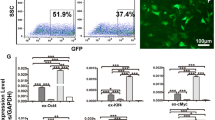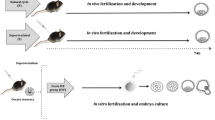Abstract
Telomere attrition and genomic instability are associated with organism aging. Concerns still exist regarding telomere length resetting in cloned embryos and ntES cells, and possibilities of premature aging of cloned animals achieved by somatic cell nuclear transfer (SCNT). Trichostatin A (TSA), a histone deacetylase inhibitor, effectively improves the developmental competence of cloned embryos and animals, and recently contributes to successful generation of human ntES cells by SCNT. To test the function of TSA on resetting telomere length, we analyzed telomeres in cloned blastocysts and pigs following treatment of SCNT embryos with TSA. Here, we show that telomeres of cloned pigs generated by standard SCNT methods are not effectively restored, compared with those of donor cells, however TSA significantly increases telomere lengths in cloned pigs. Telomeres elongate in cloned porcine embryos during early cleavage from one-cell to four-cell stages. Notably, TSA facilitates telomere lengthening of cloned embryos mainly at morula-blastocyst stages. Knockdown of pTert by shRNA in donor cells reduces telomerase activity in cloned blastocysts but does not abrogate telomere elongation in the TSA-treated embryos (p > 0.05). However, genes associated with recombination or telomerase-independent mechanism of alternative lengthening of telomeres (ALT) Rad50 and BLM show increased expression in TSA-treated embryos. These data suggest that TSA may promote telomere elongation of cloned porcine embryos by ALT. Together, TSA can elongate telomeres in cloned embryos and piglets, and this could be one of the mechanisms underlying improved development of cloned embryos and animals treated with TSA.




Similar content being viewed by others
References
Shiels, P. G., Kind, A. J., Campbell, K. H., et al. (1999). Analysis of telomere lengths in cloned sheep. Nature, 399, 316–317.
Betts, D., Bordignon, V., Hill, J., et al. (2001). Reprogramming of telomerase activity and rebuilding of telomere length in cloned cattle. Proceedings of the National Academy of Sciences of the United States of America, 98, 1077–1082.
Kubota, C., Tian, X. C., & Yang, X. (2004). Serial bull cloning by somatic cell nuclear transfer. Nature Biotechnology, 22, 693–694.
Kurome, M., Hisatomi, H., Matsumoto, S., et al. (2008). Production efficiency and telomere length of the cloned pigs following serial somatic cell nuclear transfer. Journal of Reproduction and Development, 54, 254–258.
Jeon, H. Y., Hyun, S. H., Lee, G. S., et al. (2005). The analysis of telomere length and telomerase activity in cloned pigs and cows. Molecular Reproduction and Development, 71, 315–320.
Jiang, L., Carter, D. B., Xu, J., Yang, X., Prather, R. S., & Tian, X. C. (2004). Telomere lengths in cloned transgenic pigs. Biology of Reproduction, 70, 1589–1593.
Lanza, R. P., Cibelli, J. B., Blackwell, C., et al. (2000). Extension of cell life-span and telomere length in animals cloned from senescent somatic cells. Science, 288, 665–669.
Alexander, B., Coppola, G., Perrault, S. D., Peura, T. T., Betts, D. H., & King, W. A. (2007). Telomere length status of somatic cell sheep clones and their offspring. Molecular Reproduction and Development, 74, 1525–1537.
Miyashita, N., Kubo, Y., Yonai, M., et al. (2011). Cloned cows with short telomeres deliver healthy offspring with normal-length telomeres. Journal of Reproduction and Development, 57, 636–642.
Kato, Y., Tani, T., & Tsunoda, Y. (2000). Cloning of calves from various somatic cell types of male and female adult, newborn and fetal cows. Journal of Reproduction and Fertility, 120, 231–237.
Jeon, H. Y., Jeong, Y. W., Kim, Y. W., et al. (2012). Senescence is accelerated through donor cell specificity in cloned pigs. International Journal of Molecular Medicine, 30, 383–391.
Dang-Nguyen, T. Q., Haraguchi, S., Akagi, S., et al. (2012). Telomere elongation during morula-to-blastocyst transition in cloned porcine embryos. Cellular Reprogramming, 14, 514–519.
Kishigami, S., Bui, H. T., Wakayama, S., et al. (2007). Successful mouse cloning of an outbred strain by trichostatin A treatment after somatic nuclear transfer. Journal of Reproduction and Development, 53, 165–170.
Li, J., Svarcova, O., Villemoes, K., et al. (2008). High in vitro development after somatic cell nuclear transfer and trichostatin A treatment of reconstructed porcine embryos. Theriogenology, 70, 800–808.
Shi, L. H., Ai, J. S., Ouyang, Y. C., et al. (2008). Trichostatin A and nuclear reprogramming of cloned rabbit embryos. Journal of Animal Science, 86, 1106–1113.
Wakayama, S., Kohda, T., Obokata, H., et al. (2013). Successful serial recloning in the mouse over multiple generations. Cell Stem Cell, 12, 293–297.
Tachibana, M., Amato, P., Sparman, M., et al. (2013). Human embryonic stem cells derived by somatic cell nuclear transfer. Cell, 153, 1228–1238.
Hou, M., Wang, X., Popov, N., et al. (2002). The histone deacetylase inhibitor trichostatin A derepresses the telomerase reverse transcriptase (hTERT) gene in human cells. Experimental Cell Research, 274, 25–34.
Schaetzlein, S., Lucas-Hahn, A., Lemme, E., et al. (2004). Telomere length is reset during early mammalian embryogenesis. Proceedings of the National Academy of Sciences of the United States of America, 101, 8034.
Liu, L., Bailey, S. M., Okuka, M., et al. (2007). Telomere lengthening early in development. Nature Cell Biology, 9, 1436–1441.
Ji, G., Liu, K., Chen, C., et al. (2012). Conservation and characterization of unique porcine interstitial telomeric sequences. Science China. Life Sciences, 55, 1029–1037.
Ji, G., Ruan, W., Liu, K., et al. (2013). Telomere reprogramming and maintenance in porcine iPS cells. PLoS One, 8, e74202.
Samstein, B., & Platt, J. L. (2001). Physiologic and immunologic hurdles to xenotransplantation. Journal of the American Society of Nephrology, 12, 182–193.
Vodicka, P., Smetana, K., Jr., Dvorankova, B., et al. (2005). The miniature pig as an animal model in biomedical research. Annals of the New York Academy of Sciences, 1049, 161–171.
Lai, L., Park, K. W., Cheong, H. T., et al. (2002). Transgenic pig expressing the enhanced green fluorescent protein produced by nuclear transfer using colchicine-treated fibroblasts as donor cells. Molecular Reproduction and Development, 62, 300–306.
Kong, Q. R., Zhu, J., Huang, B., et al. (2011). TSA improve transgenic porcine cloned embryo development and transgene expression. Yi Chuan, 33, 749–756.
Callicott, R. J., & Womack, J. E. (2006). Real-time PCR assay for measurement of mouse telomeres. Comparative Medicine, 56, 17–22.
Cawthon, R. M. (2002). Telomere measurement by quantitative PCR. Nucleic Acids Research, 30, e47.
Jin, H., Wang, J., Wang, F., Ma, J., Mu, Y., & Liu, Z. (2013). Porcine VHL gene cloning and construction of VHL knockdown cloned embryos. Sheng Wu Gong Cheng Xue Bao, 29, 716–725.
Ji, G., Liu, K., Okuka, M., Liu, N., & Liu, L. (2012). Association of telomere instability with senescence of porcine cells. BMC Cell Biology, 13, 36.
Muntoni, A., & Reddel, R. R. (2005). The first molecular details of ALT in human tumor cells. Human Molecular Genetics, 14(Spec No. 2), R191–R196.
Bressan, D. A., Baxter, B. K., & Petrini, J. H. (1999). The Mre11-Rad50-Xrs2 protein complex facilitates homologous recombination-based double-strand break repair in Saccharomyces cerevisiae. Molecular and Cellular Biology, 19, 7681–7687.
Stavropoulos, D. J., Bradshaw, P. S., Li, X., et al. (2002). The Bloom syndrome helicase BLM interacts with TRF2 in ALT cells and promotes telomeric DNA synthesis. Human Molecular Genetics, 11, 3135–3144.
Biessmann, H., & Mason, J. (1997). Telomere maintenance without telomerase. Chromosoma, 106, 63–69.
Huang, J., Wang, F., Okuka, M., et al. (2011). Association of telomere length with authentic pluripotency of ES/iPS cells. Cell Research, 21, 779–792.
Wright, W. E., Piatyszek, M. A., Rainey, W. E., Byrd, W., & Shay, J. W. (1996). Telomerase activity in human germline and embryonic tissues and cells. Developmental Genetics, 18, 173–179.
Blasco, M. A. (2007). The epigenetic regulation of mammalian telomeres. Nature Reviews Genetics, 8, 299–309.
Yamanaka, K., Sugimura, S., Wakai, T., Kawahara, M., & Sato, E. (2009). Acetylation level of histone H3 in early embryonic stages affects subsequent development of miniature pig somatic cell nuclear transfer embryos. Journal of Reproduction and Development, 55, 638–644.
Iager, A. E., Ragina, N. P., Ross, P. J., et al. (2008). Trichostatin A improves histone acetylation in bovine somatic cell nuclear transfer early embryos. Cloning and Stem Cells, 10, 371–379.
Cervera, R. P., Marti-Gutierrez, N., Escorihuela, E., Moreno, R., & Stojkovic, M. (2009). Trichostatin A affects histone acetylation and gene expression in porcine somatic cell nucleus transfer embryos. Theriogenology, 72, 1097–1110.
Maalouf, W. E., Liu, Z., Brochard, V., et al. (2009). Trichostatin A treatment of cloned mouse embryos improves constitutive heterochromatin remodeling as well as developmental potential to term. BMC Developmental Biology, 9, 11.
Jarrell, V. L., Day, B. N., & Prather, R. S. (1991). The transition from maternal to zygotic control of development occurs during the 4-cell stage in the domestic pig, Sus scrofa: quantitative and qualitative aspects of protein synthesis. Biology of Reproduction, 44, 62–68.
Tomanek, M., Kopecny, V., & Kanka, J. (1989). Genome reactivation in developing early pig embryos: an ultrastructural and autoradiographic analysis. Anatomy and Embryology (Berlin), 180, 309–316.
Choi, J. H., Min, N. Y., Park, J., et al. (2010). TSA-induced DNMT1 down-regulation represses hTERT expression via recruiting CTCF into demethylated core promoter region of hTERT in HCT116. Biochemical and Biophysical Research Communications, 391, 449–454.
Sahin, E., Colla, S., Liesa, M., et al. (2011). Telomere dysfunction induces metabolic and mitochondrial compromise. Nature, 470, 359–365.
Park, J. I., Venteicher, A. S., Hong, J. Y., et al. (2009). Telomerase modulates Wnt signalling by association with target gene chromatin. Nature, 460, 66–72.
Takahashi, M. (2012). Oxidative stress and redox regulation on in vitro development of Mammalian embryos. Journal of Reproduction and Development, 58, 1.
Acknowledgments
This work was supported by a grant from the National Basic Research Program of China (973 Program, No.932004, 2011CBA01000 and 2009CB941000) and the Fund for Outstanding Young Scholars in Heilongjiang Province (No.JC200905). The authors gratefully acknowledge Bio-X Vision Biological Technology Co., Ltd for Western blot analysis.
Conflict of interest
The authors declare no potential conflicts of interest.
Author information
Authors and Affiliations
Corresponding authors
Additional information
Qingran Kong and Guangzhen Ji contribute equally to this work.
Electronic supplementary material
Below is the link to the electronic supplementary material.
Fig. S1
Telomerase knockdown by RNAi in porcine fibroblasts. A: Significant reduction in pTert mRNA was induced by four pTert shRNAs in TSA-treated porcine fibroblasts. B: sh1 and sh2 co-induced a more efficient reduction of pTert mRNA in TSA-treated porcine fibroblasts. C: Western blot analysis showed pTert protein was effectively knocked down by sh1 and sh2 in TSA-treated porcine fibroblasts. Abbreviations are as follows: C, porcine fibroblasts; T-C, TSA-treated porcine fibroblasts; sh1-sh4, shRNAs; sh1/2, sh1 and sh2; and shC, control shRNA. * indicates p<0.05. (JPEG 12 kb)
Supplementary Table 1
(DOCX 17 kb)
Rights and permissions
About this article
Cite this article
Kong, Q., Ji, G., Xie, B. et al. Telomere Elongation Facilitated by Trichostatin A in Cloned Embryos and Pigs by Somatic Cell Nuclear Transfer. Stem Cell Rev and Rep 10, 399–407 (2014). https://doi.org/10.1007/s12015-014-9499-y
Published:
Issue Date:
DOI: https://doi.org/10.1007/s12015-014-9499-y




